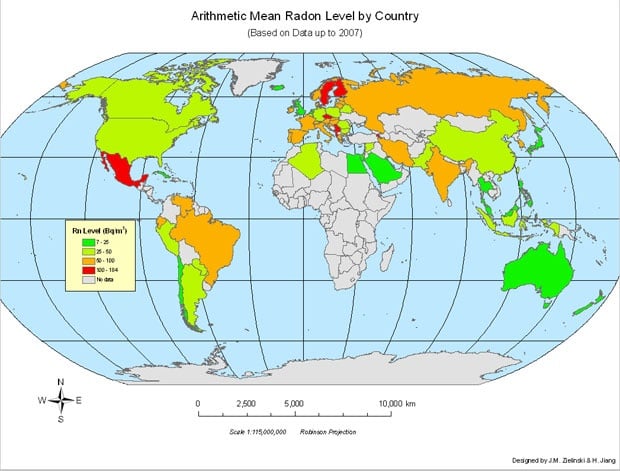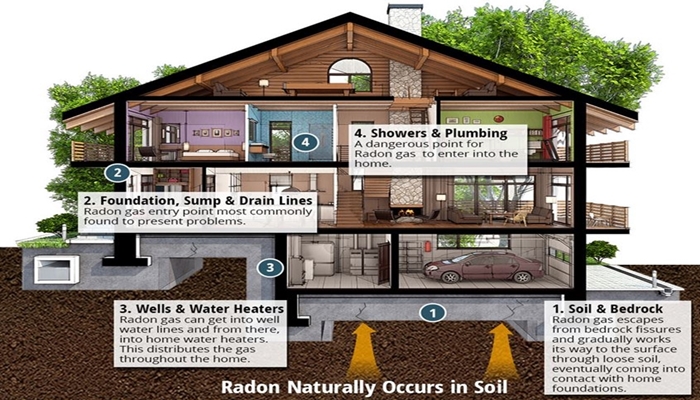The initial battery-operated smart interior air high quality screen with Radon discovery, consisting of sensing units for temperature, air pressure, humidity, VOCs, and CARBON DIOXIDE. Picocuries per liter of air, or pCi/L, which is among the favored dimensions for the speed of degeneration in radon, amounts to one trillionth of a curie, abbreviated as pCi. The pCi unit is utilized in the USA due to the fact that it is called for by government regulation.
Is radon something to worry about?
The average home has about 1.3 pCi/L of radon. Such levels aren't enough to worry about, but under the right conditions, they could make you sick. According to the EPA, a nonsmoker who was exposed to average levels of radon for a lifetime would have a 1 in 500 risk of developing lung cancer.
Radon breaks down into solid radioactive elements called radon progeny (such as lead-214, polonium-214, as well as polonium-218). Radon kids can affix to dust and other bits and can be infused the lungs. As radon as well as radon children airborne break down, they release radiation that can harm the DNA inside the body's cells. You can help in reducing your danger of cancer by making healthy choices like eating right, staying energetic and also not smoking cigarettes.
What are the chances of getting lung cancer from radon?
Granite, like any other stone, may contain veins of naturally occurring radioactive elements like uranium, thorium, and their radioactive decay products. If present, uranium, thorium or radium will decay into radon, a colorless, odorless, radioactive gas that may cause lung cancer.
Misconception 3: Evaluating your house for radon is costly and also lengthy.
Nearly everywhere else that makes use of the metric system, including the Globe Health and wellness Company, measures in Becquerels. They need to also be able to provide tips for maintaining your house safe, such as consistently looking for and securing up cracks in your structure. Offered in both lasting as well as short-term tracking, the tests are very easy to make use of and call for minimal setup.

Can you smell radon?
The “safe” level of radon exposure is no radon at all. The EPA's recommended level for radon mitigation is 4.0 pCi/L or above. It's estimated that 1 in 15 American homes have an elevated level of radon gas.
How do I make my house safe from radon?
Install a layer of gas-permeable aggregate, such as four inches of gravel, beneath the slab or flooring system of your home if you don't have a crawlspace. Cover this layer or your crawlspace floor with plastic sheeting to stop radon gas from moving past that level and into your home.
Techniques to measure an individual's exposure to radon in time have actually become extra exact, thanks to a variety of researches performed in the 1990s and also very early 2000s. Despite this type of construction, there are effective methods to lower radon. As an example, if a residence has a sump, a four-inch pipe attached to a secured cover on the sump can route incoming dirt gases to the radon follower.
Would you buy a house with radon?
Radon is a naturally occurring radioactive gas which may be found in indoor environments such as homes, schools, and workplaces. Radon is the most important cause of lung cancer after smoking.
This enables radon to relocate under your house, however it only functions if you have a cellar or piece foundation. Radon can come up with the ground and also into your home through cracks in the structure. Once it's via the cracks, it can get entraped inside, where it accumulates.
Can I install my own radon mitigation system?
In most cases, pros charge about $1,500 to install a radon mitigation system, but you can do it yourself for only about $500 in materials. So if you're fairly handy and have some carpentry, https://blogfreely.net/villeeekev/at-least-you-may-learn-you-do-have-high-radon-degrees-enabling-you-to-take plumbing and electrical skills, you can install your own system in a weekend and save yourself a thousand bucks!
Does seller have to fix radon?
It's very likely that your future buyer will make you fix the radon problem before they will purchase the home. It's good to just take care of it during your real estate deal. Sometimes the seller pays for it all, sometimes they fund a credit and sometimes there is a split.
Where is radon found in the home?
Radon is a radioactive gas that has been found in homes all over the United States. It comes from the natural breakdown of uranium in soil, rock, and water and gets into the air you breathe. Radon typically moves up through the ground to the air above and into your home through cracks and other holes in the foundation.
How common is radon in a home?
It's common: About 1 in every 15 homes has what's considered an elevated radon level. The gas is odorless and invisible, says the EPA, and it causes no immediate symptoms, so the only way to know if your home is affected is by testing your individual residence.
- The World Health Company suggest that a house be reduced when its validated radon Visit this link level Visit this site is 2.7 pCi/L or over.
- This option allows total risks from exposure to radon, both through air as well as water, to be lowered.
- High degrees of radon in residences can be efficiently remediated by securing such entry points and by mounting adequate air flow.
- No level of radon direct exposure is thought about totally secure, nevertheless the EPA just advises reducing radon levels in your house if your long-lasting exposure standards 4 picocuries per litre (pCI/L) or higher.
- If you have evaluated the air in your home as well as discovered a radon problem, as well as your water comes from a well, have your water tested.
Is radon heavier than air?
Radon gas is approximately 7.5 times heavier than air. It is however a noble gas with no chemical affinity but is easily influenced by air movements and pressure. In a house with forced air heating and cooling, radon gas can easily be distributed throughout the entire dwelling.
Is a radon level of 5 bad?
Safe radon levels. The best radon level measurement would be zero. The average global outdoor radon level varies between 5-15 Bq/m3, equal to 0.135-0.405 pCi/L. For every 99.9 Bq/m3, or every 2.7 pCI/L increase in long term radon exposure, lung cancer risk rises 16 percent.
What do you do if your house has radon?
Radon can seep into any home that is in contact with the ground. It is undetectable unless you perform a radon test. It is the second leading cause of lung cancer and according to the EPA and CDC, it kills more than 20,000 annually. It is not something you want in the home you are buying.
Is radon really a big deal?
Radon is a radioactive gas that has been found in homes all over the United States. It comes from the natural breakdown of uranium in soil, rock, and water and gets into the air you breathe. Radon typically moves up through the ground to the air above and into your home through cracks and other holes in the foundation.
How effective is radon remediation?

The Surgeon General and the EPA recommend testing for radon and reducing radon in homes that have high levels. Fix your home if your radon level is confirmed to be 4 picocuries per liter (pCi/L) or higher. Radon reduction systems work. Some radon reduction systems can reduce radon levels in your home by up to 99%.
Is it hard to sell a house with radon?
Fortunately, it's not hard to sell a house with radon, provided that you alert potential buyers and mitigate the problem, say Brian Thomas, a top real estate agent in the Denver, Colorado area, with 16 years of experience. “For as much fear and uncertainty as radon causes, there's an easy fix.”
How bad is a radon level of 8?
The EPA strongly recommends radon mitigation if your radon levels are above 4 pCi/L. While radon levels below 4 still pose a health risk. They recommend you consider mitigation if your radon levels are between 2 and 4 pCi/L. They are quick to point out that there is no known safe level of radon.
How much does radon cost per gram?
Radon is available at a cost of about $4/mCi.
Is a radon level of 2 safe?
Radon levels are measured in picocuries per liter, or pCi/L. Levels of 4 pCi/L or higher are considered hazardous. Radon levels less than 4 pCi/L still pose a risk and in many cases can be reduced, although it is difficult to reduce levels below 2 pCi/L. Once installed, a follow-up radon test is done.